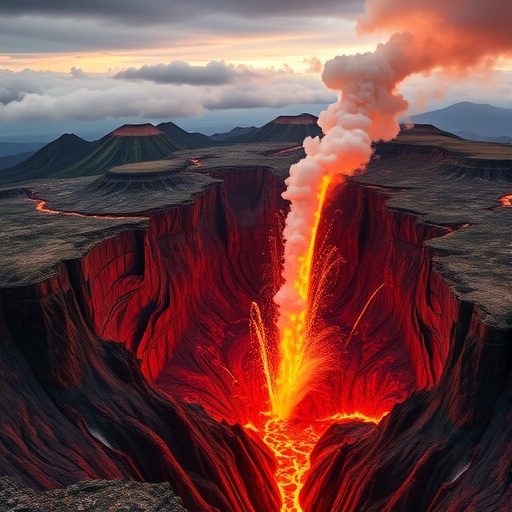In a breakthrough study published in Nature Communications, researchers have unveiled a fascinating geological mechanism that could have dramatically influenced one of the most pivotal biological events in Earth’s history—the Cambrian Explosion. This period, roughly 541 million years ago, marks a time when complex multicellular life diversified explosively, birthing most of the major animal lineages that persist today. The new research highlights the critical role played by continental arc volcanism and its capacity to enhance erosion, which consequently may have served as a powerful driver for this evolutionary burst.
The crux of the study lies in the connection between volcanic activity, erosion rates, and nutrient cycling. Continental arc volcanism occurs when oceanic tectonic plates are subducted beneath continental plates, generating voluminous volcanic arcs. These volcanic arcs contribute vast amounts of fresh, reactive rock material to the Earth’s surface. The researchers argue that the presence of these newly formed volcanic mountain ranges drastically accelerated erosion processes, providing an unprecedented supply of bioavailable nutrients to the oceans.
Nutrient flux into the oceans is a crucial factor influencing marine productivity. Prior to the Cambrian Explosion, marine ecosystems were relatively simple, and nutrient limitation is considered one of the binding constraints that kept biodiversity in check. By increasing nutrient delivery, enhanced erosion from volcanic arcs may have alleviated this limitation, allowing complex life forms to thrive. This new nutrient influx likely fostered enhanced primary productivity, setting the stage for ecological complexity and evolutionary innovation.
To establish this link, the authors employed a multidimensional modeling approach integrating geochronology, geochemical proxies, and sedimentary records. Their data indicate sharp increases in erosion rates coinciding with intensified continental arc volcanism. This erosional amplification resulted in vast quantities of sediments enriched with essential elements like phosphorus and other trace metals—key ingredients fueling biological productivity.
Further insights are drawn from sedimentological records showing elevated silica, iron, and phosphorus levels in marine deposits contemporaneous with the early Cambrian period. These elements are essential for constructing cellular components and metabolic pathways in early metazoans. Enhanced delivery of these nutrients could have stimulated swift biosphere responses, facilitating evolutionary experimentation and rapid diversification.
The volcanic arcs’ volcaniclastic sediments appear to have been particularly effective in transporting these nutrient loads into shallow marine environments. As erosion stripped down mountain belts, volcanic ash and debris were pulverized and redistributed by riverine systems. This process resulted in enriched sediment plumes that fed nascent ecosystems, increasing the habitat heterogeneity essential for evolutionary radiation.
Tectonic reconstructions reveal that the Cambrian was characterized by intense subduction and orogeny, amplifying the creation of continental arcs. This tectonic dynamism systematically brought fresh volcanic rock surfaces into the erosional cycle. In turn, this eroded material simultaneously modified ocean chemistry and increased the burial rate of organic carbon—key factors in regulating atmospheric oxygen levels, which are also thought to influence biological complexity.
Atmospheric oxygen levels have been hypothesized as constraints on multicellularity prior to the Cambrian. The study indicates that the enhanced erosion not only supplied nutrients but also contributed to oxygenation of Earth’s surface environment by promoting organic carbon burial. This inadvertently increased oxygen concentrations in shallow marine waters, further enabling the emergence of metabolically demanding organisms.
One of the intriguing aspects of this research is how it integrates various disciplines—geochemistry, paleoenvironmental studies, and evolutionary biology—into a cohesive narrative explaining the Cambrian Explosion. By emphasizing physical Earth processes such as volcanism and erosion, the study moves beyond purely biological explanations and frames early animal evolution within the context of planetary-scale geodynamics.
The authors also address longstanding debates about the causes of the Cambrian Explosion by identifying continental arc volcanism as a driver compatible with observed sedimentary and geochemical signatures. This challenges previously held assumptions that biological innovation alone or isolated oxygen spikes were sufficient to explain the period’s biodiversity burst.
Moreover, the scale of erosion linked to continental arc volcanism represents a dramatic departure from prior epochs. The study’s quantitative models suggest erosion rates increased by orders of magnitude, supporting a scenario where Earth’s surface environment was rapidly reconfigured. These changes could have fundamentally transformed nutrient cycles and habitats, allowing evolutionary novelty on unprecedented scales.
Importantly, this research highlights feedback loops between Earth’s interior, surface processes, and biosphere evolution. The interplay between tectonic forces, erosion, nutrient cycling, and biological innovation exemplifies the integrated nature of Earth system processes. Understanding such feedbacks is crucial in deciphering planetary habitability and the conditions necessary for complex life to flourish.
Future research inspired by this study could target specific sedimentary basins to identify localized records of nutrient enrichment tied to volcanic arcs. Additionally, investigating other periods of intense arc volcanism could reveal whether similar evolutionary accelerations occurred, or if the Cambrian Explosion represents a uniquely tectonically-influenced biological event.
In conclusion, this novel study by Wu, Tian, Fan, and colleagues pioneers a comprehensive explanation that continental arc volcanism, by enhancing erosion and nutrient supply, catalyzed the Cambrian Explosion. This tectonically-driven mechanism sheds light on the interconnectedness of Earth’s geosphere and biosphere and opens new horizons for understanding the origins of animal complexity on our planet.
Subject of Research: The role of continental arc volcanism-enhanced erosion as a driver for the Cambrian Explosion.
Article Title: Enhanced erosion by continental arc volcanism as a driver of the Cambrian Explosion.
Article References:
Wu, Y., Tian, H., Fan, H. et al. Enhanced erosion by continental arc volcanism as a driver of the Cambrian Explosion. Nat Commun 16, 9204 (2025). https://doi.org/10.1038/s41467-025-64253-w
Image Credits: AI Generated




